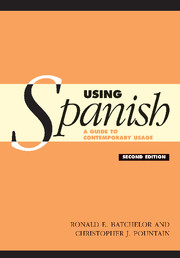Book contents
- Frontmatter
- Contents
- Authors' acknowledgements
- Preface to the second edition
- List of abbreviations and symbols
- Glossary
- The Spanish speaking world: countries where Spanish is spoken, with an estimate of the numbers of native speakers
- 1 Introduction
- 2 Passages illustrating register and local variety
- Part I Vocabulary
- Part II Grammar
- 21 Gender
- 22 Number
- 23 Word order
- 24 Prepositions
- 25 Prepositional constructions with verbs, nouns and adjectives
- 26 Constructions with verbs of movement
- 27 Negation
- 28 Use of tenses
- 29 Periphrastic verb forms
- 30 Modal auxiliaries
- 31 The Subjunctive
- 32 ser and estar
- 33 Personal pronouns
- 34 The reflexive
- 35 Comparison
- 36 Usage with names of countries
- Index
36 - Usage with names of countries
Published online by Cambridge University Press: 05 June 2012
- Frontmatter
- Contents
- Authors' acknowledgements
- Preface to the second edition
- List of abbreviations and symbols
- Glossary
- The Spanish speaking world: countries where Spanish is spoken, with an estimate of the numbers of native speakers
- 1 Introduction
- 2 Passages illustrating register and local variety
- Part I Vocabulary
- Part II Grammar
- 21 Gender
- 22 Number
- 23 Word order
- 24 Prepositions
- 25 Prepositional constructions with verbs, nouns and adjectives
- 26 Constructions with verbs of movement
- 27 Negation
- 28 Use of tenses
- 29 Periphrastic verb forms
- 30 Modal auxiliaries
- 31 The Subjunctive
- 32 ser and estar
- 33 Personal pronouns
- 34 The reflexive
- 35 Comparison
- 36 Usage with names of countries
- Index
Summary
The vast majority of countries do not take the definite article unless they are qualified by an adjective or adjectival phrase:
Voy a España
I'm going to Spain
Es de México
He's from Mexico
but
en la Italia de hace cincuenta años
in the Italy of fifty years ago
en el Chile contemporáneo
in contemporary Chile
However, there are a number of countries, both masculine and feminine, which may be preceded by the definite article. They are indicated in Chapter 10 as follows: (el) Japón, (los) Estados Unidos, (la) Argentina. Generally speaking, the use of the article is more typical of the written registers. One or two countries, notably El Salvador, have a definite article as part of their name, and it must always be used. As with names of towns (eg El Ferrol) where the article forms an integral part of the name, the article does not combine with de or a in very formal usage, eg:
en el norte de (la (R2–3)) Argentina
in the north of Argentina
el Primer Ministro de(l R2–3) Japón
the Prime Minister of Japan
la capital de El (R3) / del (R1–2) Salvador
the capital of El Salvador
- Type
- Chapter
- Information
- Using SpanishA Guide to Contemporary Usage, pp. 442Publisher: Cambridge University PressPrint publication year: 2005



